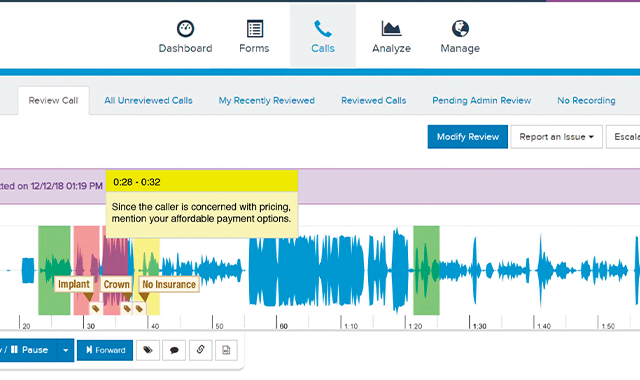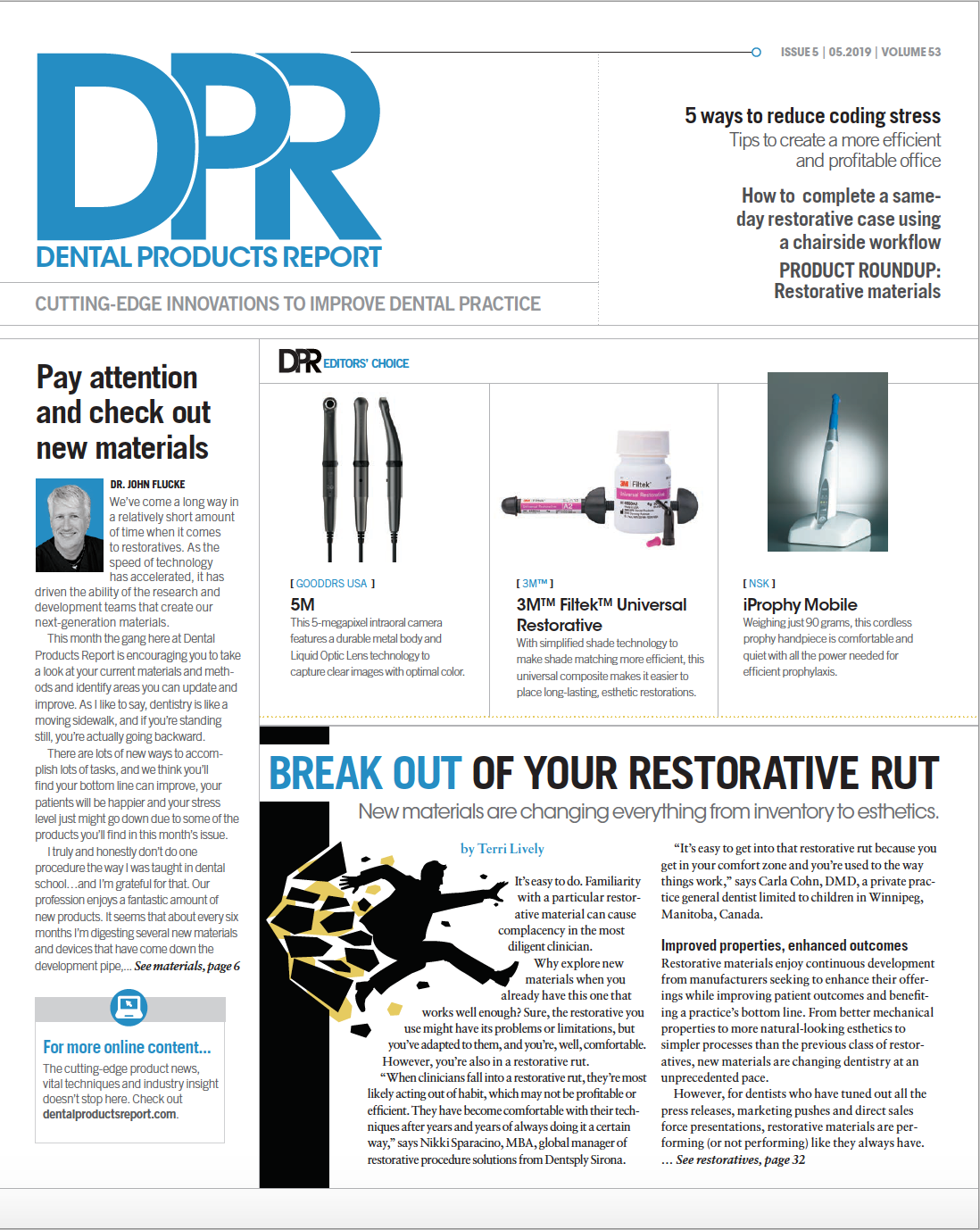Improving practice communication with Patient Prism
How this service helps the dental team respond to patients’ needs from the very first call.

What is Patient Prism®?
Patient Prism is a call tracking and coaching service that takes call monitoring to a new level. The goal is to convert more callers into booked appointments. This is done with artificial intelligence (AI) and call coaching, allowing quick intervention to influence behavior change at the front office level and ultimately help more people receive the dental care they need.
How does Patient Prism work?
Patient Prism identifies areas during the conversation that weren’t optimal from a conversion standpoint. We highlight those areas visually and include commentary from our team in Tampa, Florida, along with training videos that apply to specific aspects of each call.
A dental office team member can look at data without having to listen to a whole phone conversation and call the patient back right away to say, for example, “Sir, you called us earlier and said you had no insurance. We forgot to mention we have several financing options available for you. Let’s start by having you meet the dentist to see what can be done to fix the problem. Would a morning or an afternoon appointment work better for your schedule?”
It gives these offices a second chance to make a great first impression. It allows the front office to see failures as they happen and address them head on.
Related reading: How to ensure front desk marketing finesse
How is AI involved?
We utilize several subfields of AI, including classification algorithms, regression analysis, natural language processing, decision trees, artificial neural networks and deep learning. These tools combine to allow the machine to perform an initial quality check, which is the identification of what the patient wanted in terms of keywords. If a patient says they wanted a crown, it identifies that keyword.

The machine transcribes the call and looks at mood and sentiment to curate information for a Patient Prism coach to format and send out to the practice. It’s important for us to have humans reviewing the data and validating it because AI isn’t there yet, but the AI makes the coaches a lot more efficient at curating the feedback.
The AI is also pinpointing areas that need to be looked at. It’s not just transcribing the call and picking out keywords. It identifies if the caller is a new patient without needing to connect to a practice management system.
We’ve trained the AI to look at the commonalities in language a new patient would say on the phone. Because it classifies a call at the outset, we can focus our energies on any new patients that aren’t getting booked.
We show the receptionist where there could be gaps in communication. When a patient who needs an extraction calls, for example, the best practice is to ask if they’re in pain because you want to empathize with the patient. You can say, “Sir, are you experiencing any discomfort? Can we help you with that?” to build trust with the patient and show you care. These small things make a big difference.
How are new patients identified?
We use tracking phone numbers, which are attached to all the marketing the dental practice is doing, whether it’s Google Ads, Facebook, or YouTube. Those tracking numbers are instantly forwarded to the main line of the practice.
While we assume most of those calls are new patients, that may not always be the case. Our main focus is to ensure a new patient who calls an office is appointed. The big leak in the marketing funnel is from new patients who call as a result of seeing an ad but can’t schedule an appointment for various reasons. We can also utilize a phone tree where new patients press ‘one,’ and those calls come into our system to be analyzed.
Continue reading on page two...
Tell me about the workflow
Let’s say a call came in at 9 a.m. and the conversation lasted for five minutes, during which the patient mentioned insurance was an issue. At 9:05 a.m., the patient hung up. At 10:05 a.m., a text message or email is sent to the practice with a secure link to the call recording and visualization, which includes color-coded areas identifying where the front office could’ve handled the call better and suggest different ways to address the caller’s concerns.
There are at least two or three short videos with specific phrasing the receptionist can watch to know what to say when they call back the patient-or how to handle this type of situation in the future.
For example, if this was an out-of-network insurance patient, there would be a video about how to deal with out-of-network patients. It would encourage you to say, “Although we aren’t in-network with that insurance provider, we work with that company often and we’re more than happy to file on your behalf. Let me make a call to confirm exactly how your dental benefits can be used in our office.”
More from the author: The rise of Instagram for your dental practice
By the time the front office calls the patient back, they’ve had coaching on what to say. We have about 250 videos associated with phone conversion skills. These are recorded by some of the top consultants in the country such as Fred Joyal and Linda Miles. These scenarios answer questions such as “How do you talk to an anxious patient?” or “How do you talk to someone when there’s a language barrier?”
Can you tell me how the AI subfields you utilize function in this workflow?
The overall goal of AI is prediction. We use pattern matching, one of the early precursors to AI. We look at data analysis, where we structure the data into various fields. We use neural networks to look at hidden patterns not necessarily identified by human beings, which could bind certain cohorts of patients together.
There’s a whole list of data science tools we use to determine the prediction. In traditional regression analyses, you look at past data and provide an input (independent) variable and an output (dependent) variable to the machine. It would decide relationships and was skewed toward the dependent variable. One of the problems we saw early on was the classification dilemma.
The training model is built using an algorithm based on data you think could be relevant. Sometimes when you use neural networks, they have a way to figure out which variables are independent variables. A combination of structured data, pattern matching and neural networks form the basis.
Natural language processing (NLP) also plays a big part, which is what Alexa, Siri and Google Home are doing. Using natural language processing tools, we’re able to feed data into an engine that predicts with a certain degree of accuracy whatever you’re trying to ascertain. One of our first questions was how to predict a new patient is calling, and to what degree of accuracy this prediction could have.
What else can we do with this data?
There are many potential applications of the data we collect on the phone. Being able to see and tie together different data points, such as services requested, the type of insurance they have, how quickly they’re looking to have an appointment and whether they book or not, for example, could help dental practices figure out predictive models. How many lab supplies do they need to order for implants or Invisalign cases?
Related reading: Do you know why patients aren't coming in?
Dentists use the data we provide to find out where there are gaps in what patients are requesting and what the practice provides. They’re using it to determine if they should add Invisalign, dental implants, or same-day crowns to their services based on what people are asking for on the phone.
We can tell them how many calls come in before their office opens, how many patients are requesting early morning appointments, or how many patients are requesting appointments after the office closes. The practice can make staffing decisions based on convenience for the population they serve. These data points from an operations standpoint are of immense value.
Where do you see this technology going in the future?
We believe the technology is going to get faster in understanding. Right now, our response time to a missed new patient appointment is 60 minutes. In the near future, I’d like to get that down to half an hour. In the more distant future, I see it acting as a virtual assistant on the phone, listening to the receptionist and coaching while in the midst of a call. I also see a virtual receptionist eventually answering the phone calls, but that’s a long way off.
The technology Google Duplex introduced recently allows a virtual assistant to make an appointment, and the receptionist has no idea she’s talking to a machine. (Search “Google Duplex haircut appointment” on YouTube). It’s somewhat scary for the industry, but we hope our technology will help receptionists and call center agents know how to respond when this happens.
The best use case for us now is helping people be more efficient by providing feedback quickly, helping them serve their patients better. It’s not about replacing humans; it’s about giving them the tools and coaching so that we can have a greater chance of serving a bigger population of patients who deserve dentistry to change their lives.

How Dentists Can Help Patients Navigate Unforeseen Dental Care
December 12th 2024Practices must equip patients with treatment information and discuss potential financing options before unexpected dental treatments become too big of an obstacle and to help them avoid the risk of more costly and invasive procedures in the future.
Product Bites – January 19, 2024
January 19th 2024Product Bites makes sure you don't miss the next innovation for your practice. This week's Product Bites podcast features new launches from Adravision, Formlabs, Owandy Radiology, Henry Schein Orthodontics, Dental Creations, and Dental Blue Box. [5 Minutes]